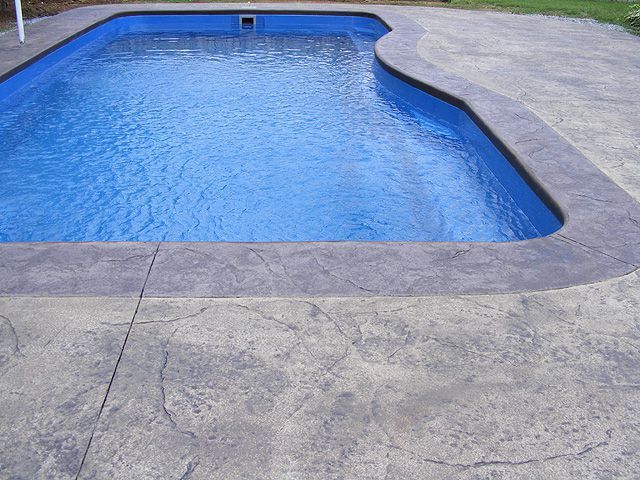
Both homeowners and business owners love to use the stamped concrete application for their pool decks. The stamps give incredible form and function to a slippery area like the pool’s surroundings.
Creating stamped patterns enhances the functions of the concrete decks and adds stunning simplicity that adds value to the pool area. Achieving these decorative pool decks is no rocket science, and however, today’s post could help you identify which method of stamping is suitable for your existing pool decks. Two terms interchange meanings.
Let’s define the thin line that draws the difference between concrete stamping and stamped overlay.
Pool decks defined: Is it stamped overlay or concrete stamping?
Let us straighten right away the surfacing confusion about these popular flooring methods. Here is a straightforward comparison.
Stamped overlay defined
The stamped overlay is a popular resurfacing application. Resurfacing means that a concrete slab has already been existing, and it might already have a permanent decorative finish as staining or stenciling.
If you see that the surface needs an upgrade or a major retouch, you must resurface it. One option is to pour or install an overlay of a thin layer of concrete mix on the existing slab.
You won’t need to dig out old slabs, and it saves you from many contingency costs and prevents you from having downtime. This is helpful, especially if you are managing commercial swimming pools. Business goes on with resurfacing the decks with concrete overlays.
Concrete stamping
Concrete stamping is not far from what concrete overlay is. In contrast, overlays are installed over existing, functioning contrite floors. Concrete stamping is the actual method of placing stamped patterns on freshly installed concrete. This can be done, for example, to patios. You can have patio concrete stamping to your property.
So, the distinct difference between the two applications only lies in one specific step.
Another important note is that since the method functions as a decorative application, another core difference is the type of concrete mix placed.
Unlike the overlay, the concrete compound may be thicker and would cure faster. On the other hand, concrete stamping requires that the mix cure slower since it would be the base component for the slab.
3 Main Categories of Stamped Overlay and Concrete Stamping
Once you are finished installing the overlay or the base concrete slab, the stamping process will finish it, and adding the stamp patterns is now where both terms overlap. When it comes to the stamping process, there are five variations or decorative finishes to your pool deck resurfacing options.
1- Textured finish
The stamped patterns usually bear a smooth and polished finish. But another way to amplify the look of stamped concrete and overlays is with texturing.
A textured finish is most useful for pool decks, of course, and you may find that repeating the same methods and patterns can look so outdated. So, expert concrete contractors now use textured finishes as the broom or spray knockdown finish to add more form and increase function on the pool decks.
Broom finish creates a rigid linear texture on the overlays. Now our ordinary stamped overlays have added slip resistance with the textured finish.
2- Dual colored stamps
One way to make the concrete stamps look more like natural stones and slate is by blending two-tone coloring. Concrete coloring is a natural part of the overlay and concrete stamping, and a classic stamped overlay would bear the earthy, warm look or neutral colors like grey or bluish stone.
But by adding another tone to the base coloring, a gradient effect would come out, making the old ordinary stamps look modern, chic, and appealing.
3- Multiple stamp patterns
You are now probably aware of the degree of complexity involved in the stamping process. A classic overlay would take on the typical stamped patterns like brick, random stone, or wood.
If you have a massive space around the pool decks, you can feature the different perspectives of the pool by creating two or more stamping patterns. Aside from finishing the overlays wth dual colors, why not alternate between two types of stamped design.
In this way, you can add dimension to the look of the pool decks. Also, that is another way to create texture on the surface, enhancing traction and slip resistance.
Final Notes
There you have it. Now you can make clear distinctions between concrete stamping and overlays.
And now you know the specific finishes. At least whether you got an overlay or the entire concrete stamping application, the categories of design apply to both.
To ensure the best quality, always consult with professional contractors. Doing so would allow you to know the suitable process the pool decks and outdoors floors would have to go through if you should have overlays or concrete stamping.